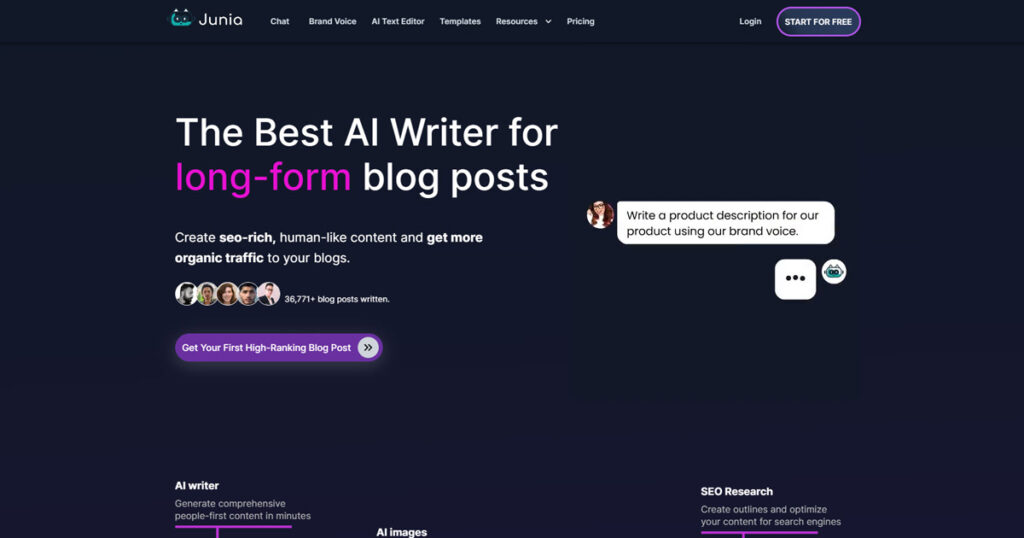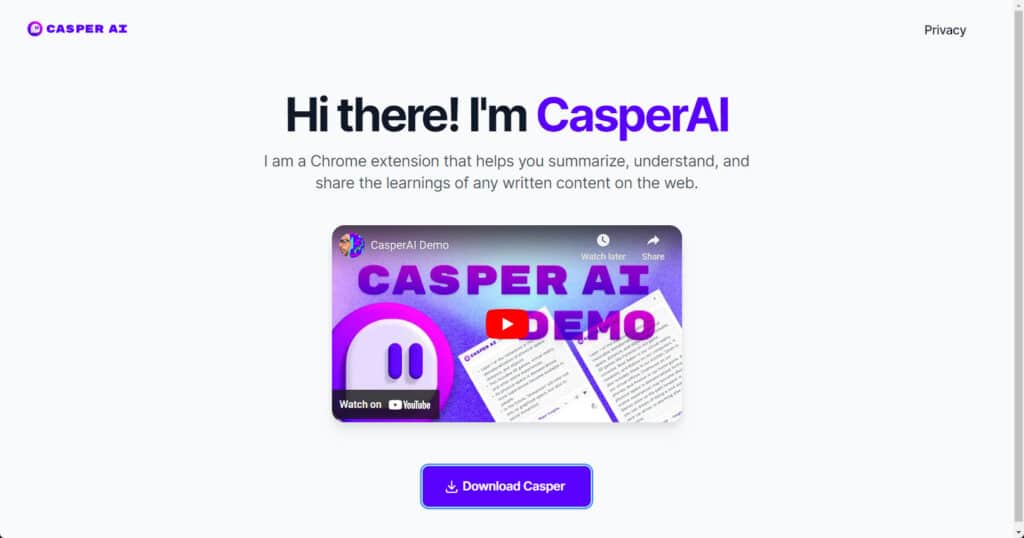Navigating the job market can be daunting, regardless of expertise and experience. Ultimately, your career trajectory hinges on one crucial document: your resume. This critical document often determines whether you land a preliminary interview, so it must capture a recruiter’s attention immediately.
Today’s HR professionals frequently utilize Applicant Tracking Systems (ATS)—digital tools that sift through resumes for pertinent keywords. This allows employers to weed out applicants whose qualifications don’t align with the job specifications. Cutting-edge ATS even incorporate elements of AI to ensure only the most fitting resumes land on a hiring manager’s desk.
In this context, the secret to an exceptional job application is an optimized resume, tailored to your specific role, industry, and sector. Rather than depending solely on templates for a compelling resume, it’s prudent to leverage generative AI capabilities to craft a resume that garners interview invitations. After all, what better tool to combat AI than AI itself?
Let’s explore how to write your resume with ChatGPT, the preeminent AI assistant, making use of prompt engineering. We’ll delve into an array of tactics that leverage its extraordinary capabilities, revolutionizing your job-seeking experience. Pair this article with our guide on how to write a cover letter with ChatGPT, and you’re primed for a rapid job-search kickoff.
The Resume Checklist
Before we dive in, it’s important to understand the backbone of an exceptional resume: a professional layout and structure. The ideal resume showcases the following details in the format demonstrated below:
Your Name
Contact Number/s
Email Address
Personal Statement/Summary
One to two sentences stating why you are a perfect match for the type of job you’re applying for.
Skills
If you’re presenting your skills below the summary, separate them with commas to make this section as compact as possible. If you must use bullet points, it’s better to place the skills section at the end of your resume to avoid overcrowding the top part.
Professional Experience
MMM YYYY – MMM YYYY
Your position – The company
Header 1
- You may list the projects you managed or participated in during your tenure in this section. They should ideally be relevant to the position you’re applying for so your application stands out.
Header 2
- You may fill this section with the responsibilities you’ve taken during your tenure. This part demonstrates your skills and how your experience makes you fit for your target position.
Education
YYYY – YYYY
Your post-graduate studies, if applicable
Name of your university
YYYY – YYYY
Your course in college, if applicable
Name of your college or university
YYYY – YYYY
Other certifications/diplomas, if applicable
Name of the institution
YYYY – YYYY
Your secondary educational attainment (e.g., High School)
Name of your school
Optional section/s
You may put character references in this section or dedicate it to your interests as some employers like to consider them. If you’ve received special awards in your field, this is also the place to mention them.
While some resumes feature the candidate’s photo, it is not mandatory. The real game-changers for your resume are its visibility, relevance, searchability, and the FOMO (Fear Of Missing Out) factor. Let’s delve into these crucial components further.
Visibility
- Prominently positioned name in large font.
- Contact details beneath your name.
- Past work listed as Title-Employer-Dates.
Relevance
- Your most recent employment matches the position sought.
- First page immediately demonstrates job and industry relevance.
- Education and job titles in comprehensible English.
- Headshot omitted.
Searchability
- Varied terminology for crucial skills and technologies.
- Diverse naming for renowned employers (if applicable).
FOMO Elements
- Engaging personal statement outlining industry experience and expertise.
- Numerical representation of past work impacts (e.g., sales growth of 30%, management of specific data volume).
A resume that ticks all the points above helps your application stand out. But writing a comprehensive resume while making the details concise can be time-consuming and a little stressful, especially if you’re working on a tight timeline. Luckily, you can build a standout resume much faster by playing around with AI.
How to Write a Resume with ChatGPT
We can use four different approaches to creating a resume with ChatGPT. We’ll begin with basic prompts and gradually transition to advanced ones.
- Asking for a resume (best if you don’t already have one or are unhappy with the current one).
- Asking for feedback on your resume.
- Asking to make specific changes to your resume.
- Asking to rewrite your resume according to best practices.
Asking ChatGPT for a Resume
ChatGPT is an excellent place to get ideas for your resume. It’s also a reliable tool for improving your existing resume.
If you need a resume template with design and fonts, Microsoft Word, Google Docs, Canva, and other online sources provide free ones. On the other hand, ChatGPT can generate the text to fill out without the need for one.
For this approach, we’ll ask ChatGPT to complete our resume template. Let’s say you’re an experienced graphic designer targeting an art director position.
Step 1 – Type your most remarkable accomplishments in the prompt field and ask ChatGPT to generate a compelling summary of that information. You may copy the prompt to try it for yourself:
Write a short, professional, and concise resume summary about my accomplishments as a [position] for [length of experience]. I’ve created [relevant pieces of work] for well-known brands, [brand names] that [impact of your work]. My work also has [type of award or recognition, if applicable, and the year].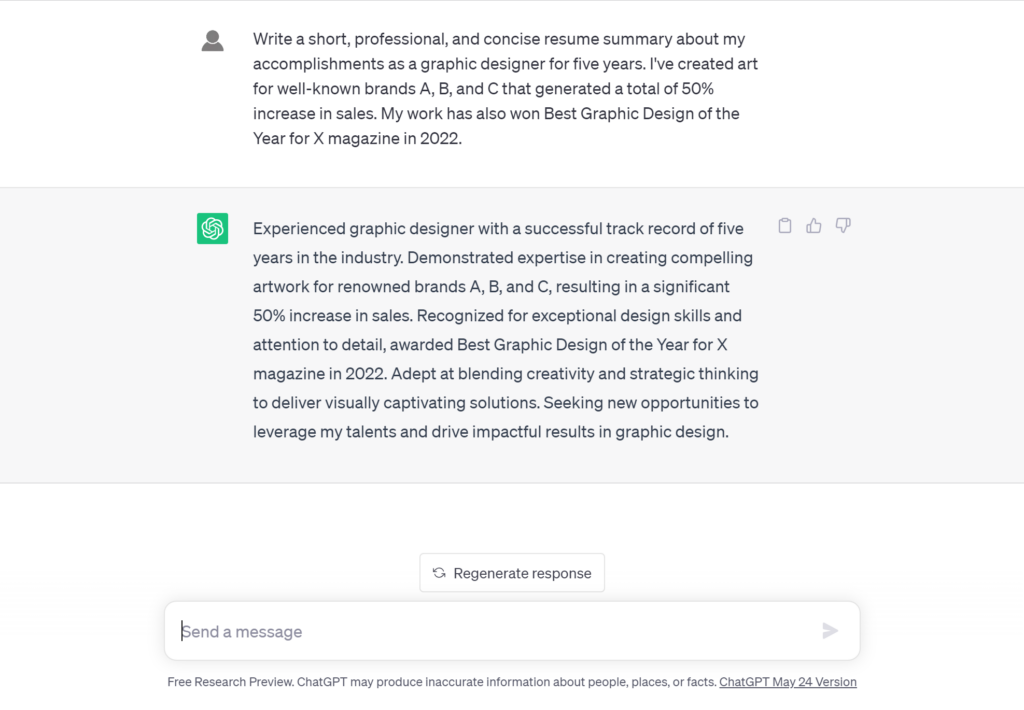
ChatGPT generated an excellent summary because it expounded on your record of success and included keywords like “attention to detail” and “strategic thinking,” which might be amongst the skills an ATS has been programmed to spot in resumes.
What if you’re a fresh graduate applying for a graphic designer role with your education as your only competitive advantage? ChatGPT can write a powerful summary for you as well. Copy the prompt to try it:
Write a short, professional, and concise resume summary about my accomplishments as an aspiring [position]. I have [your degree, certification, vocational training, etc.] from [name of educational institution] and an extensive [your portfolio or internship experience] in [your field]. I’m proficient in various [technical tools relevant in your field].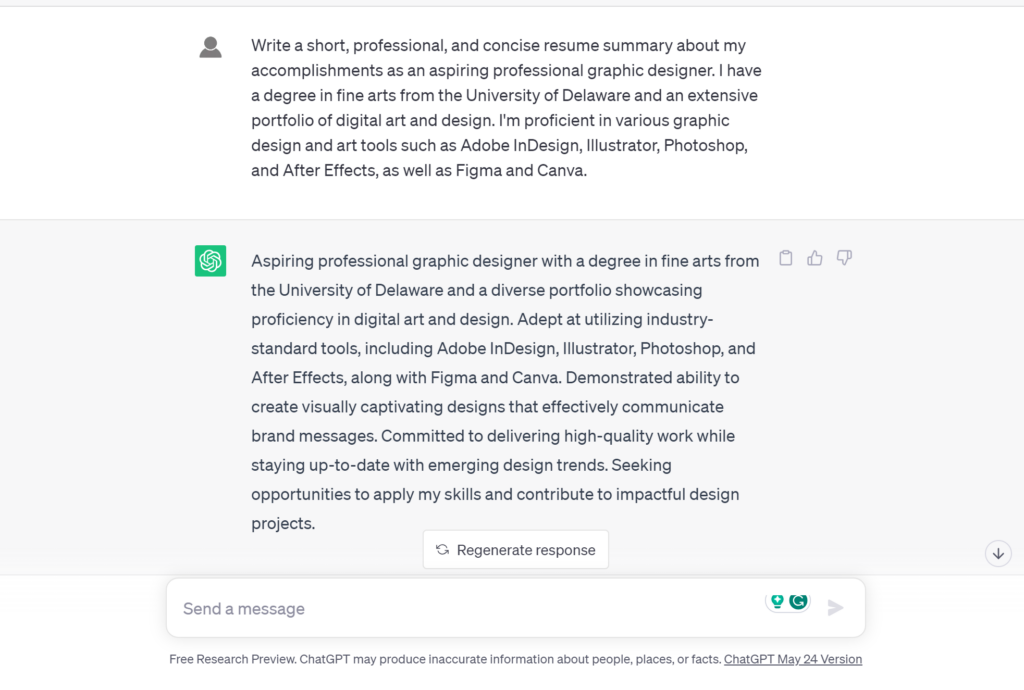
This is an outstanding summary because it highlights your education, skills, enthusiasm for seeking opportunities, and commitment to delivering high-quality work.
Let’s move on to the skills section.
Step 2 – Type your skills in the prompt field and ask ChatGPT to arrange them by relevance for the art director role. Use this prompt:
Arrange these skills in order of relevance for the position of [position name]: [your skills].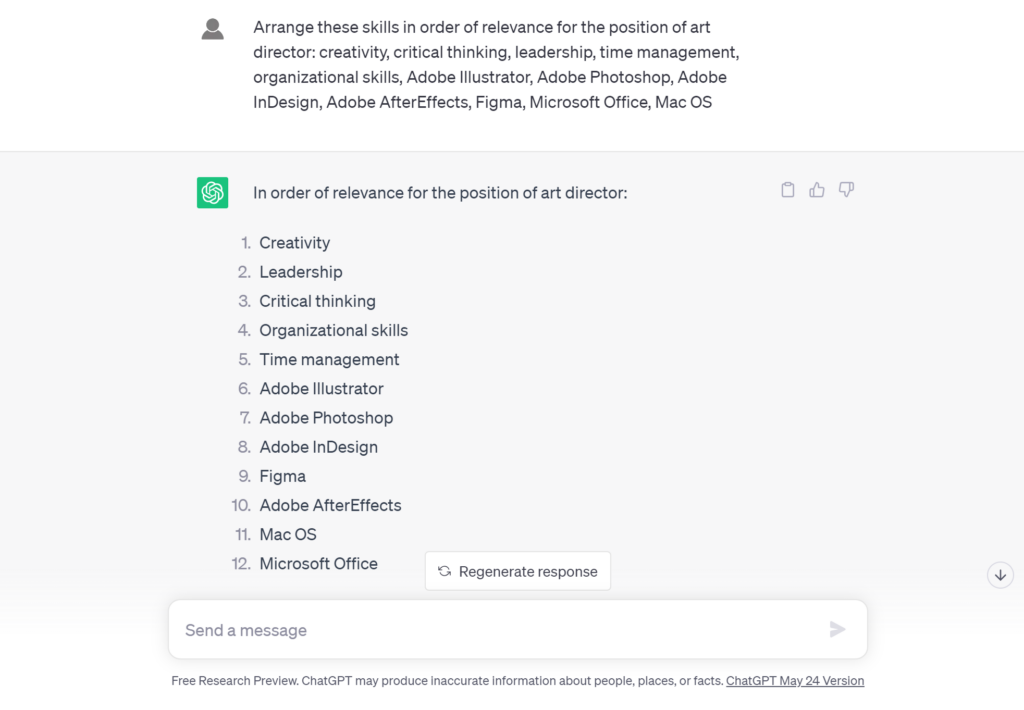
ChatGPT also added a thoughtful note below the list:
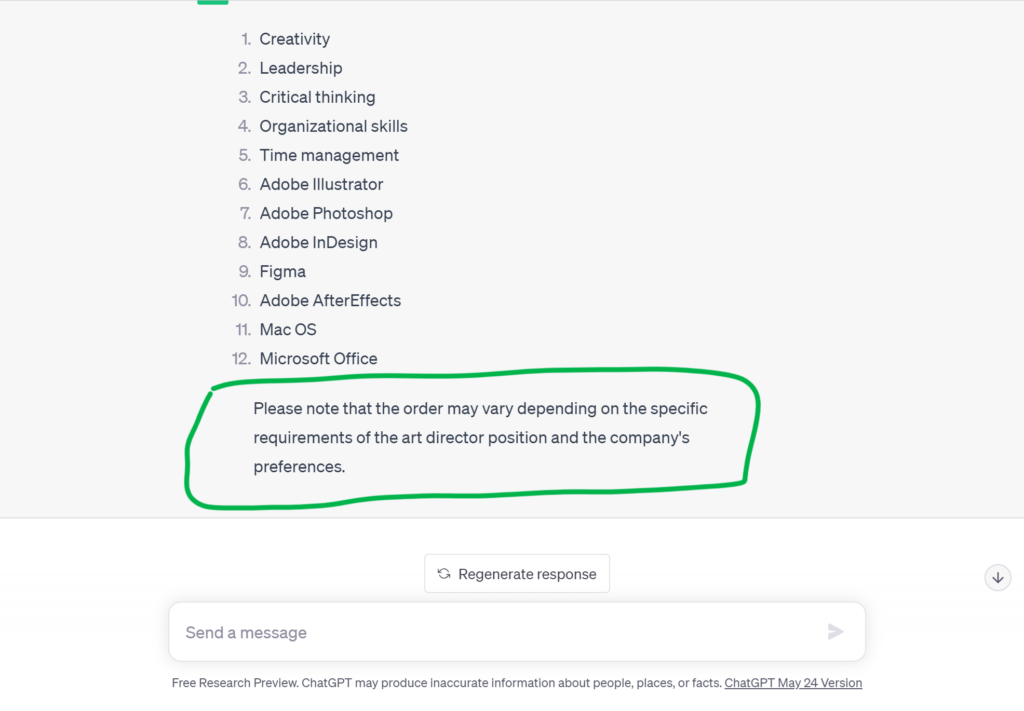
You’ll notice that soft skills came first, probably because, according to LinkedIn’s 2019 Global Talent Trends report, 92% of talent professionals consider them equally or more important than hard or technical skills. But whether soft skills are more essential than hard skills is ultimately subjective. Hence, ChatGPT urged us to note that the order of skills may vary depending on the company’s requirements for the art director position and its preferences.
If a particular company emphasizes technical skills, we can ask ChatGPT to do the same in our resume.

ChatGPT followed the prompt flawlessly and added an explanation for the ranking. It added a thoughtful note about the company’s preferences for a candidate’s skills. So you have two ways to list your skills and switch depending on the company. If the company uses an ATS, your resume will pass the initial screening if it contains the right keywords.
Step 3 – Ask ChatGPT to break down your professional experience. Specifying timelines and accomplishments for every job you’ve taken over the years is crucial. Use this prompt:
Create the professional experience section of my resume with the following details:
“[List of your work experiences with accompanying accomplishments]”
Step 4 – Assess ChatGPT’s response. Make adjustments as needed.
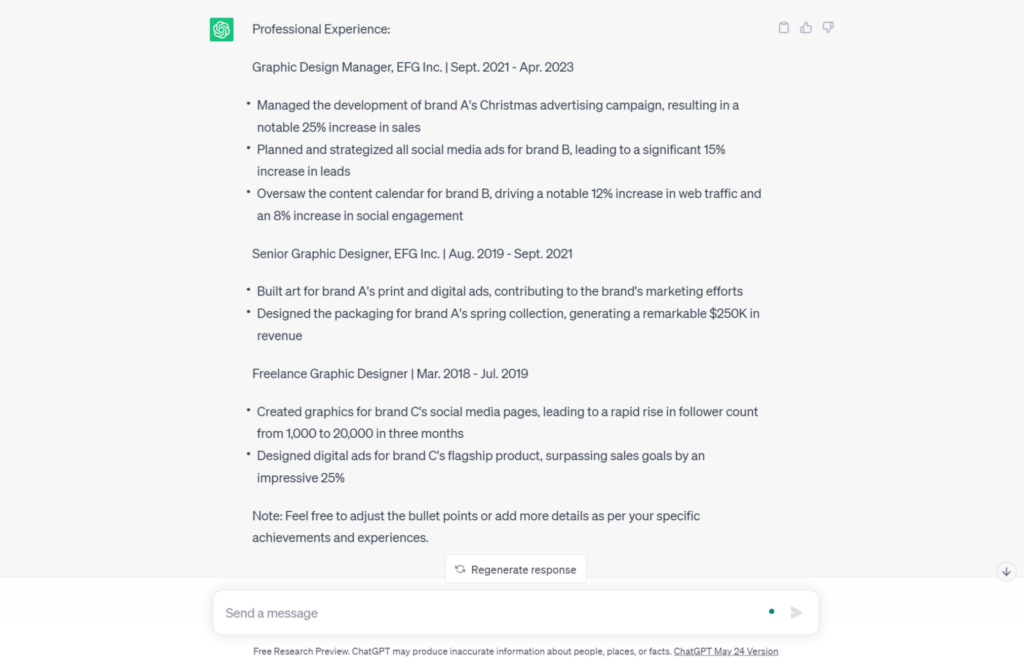
This template follows the title-employer-dates format, although it uses different characters since our prompt wasn’t particular about the characters to be used. However, ChatGPT’s structure isn’t incorrect at all. It clearly shows the titles, company names, and dates. It also explains the accomplishments with high-impact adjectives, which can pitch you better to the recruiter.
We’re almost done; all that’s left now are the education and miscellaneous sections. Let’s start on those in the next step.
Step 5 – Ask ChatGPT to create the education section of your resume. Use this prompt:
Create the education section of my resume with the following details:
“[List of your education details with time ranges and school names]”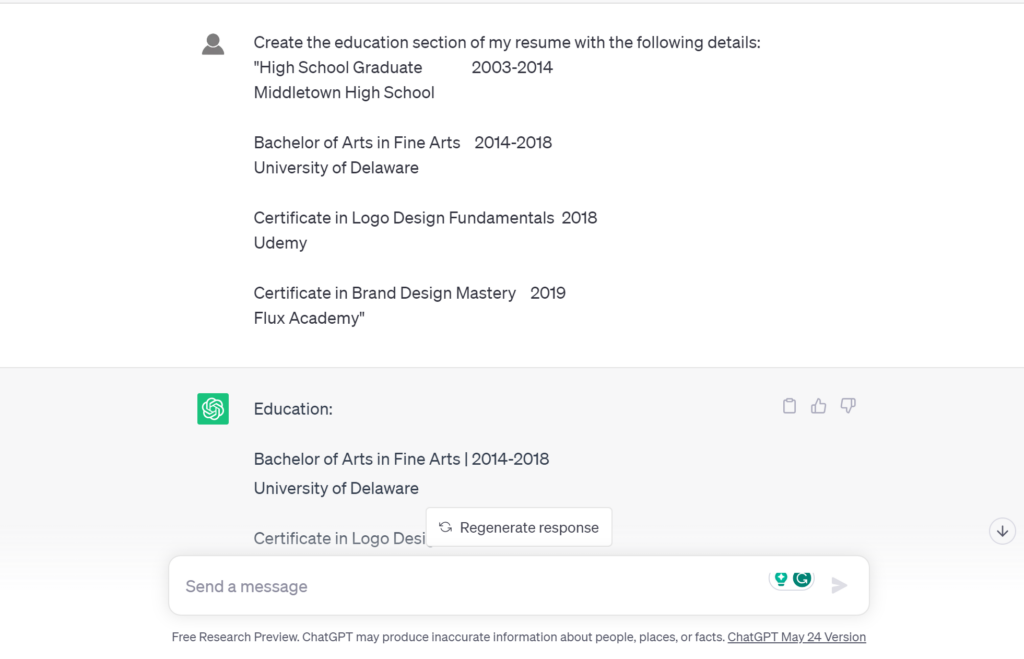
Step 6 – Assess ChatGPT’s response. Make adjustments as needed.
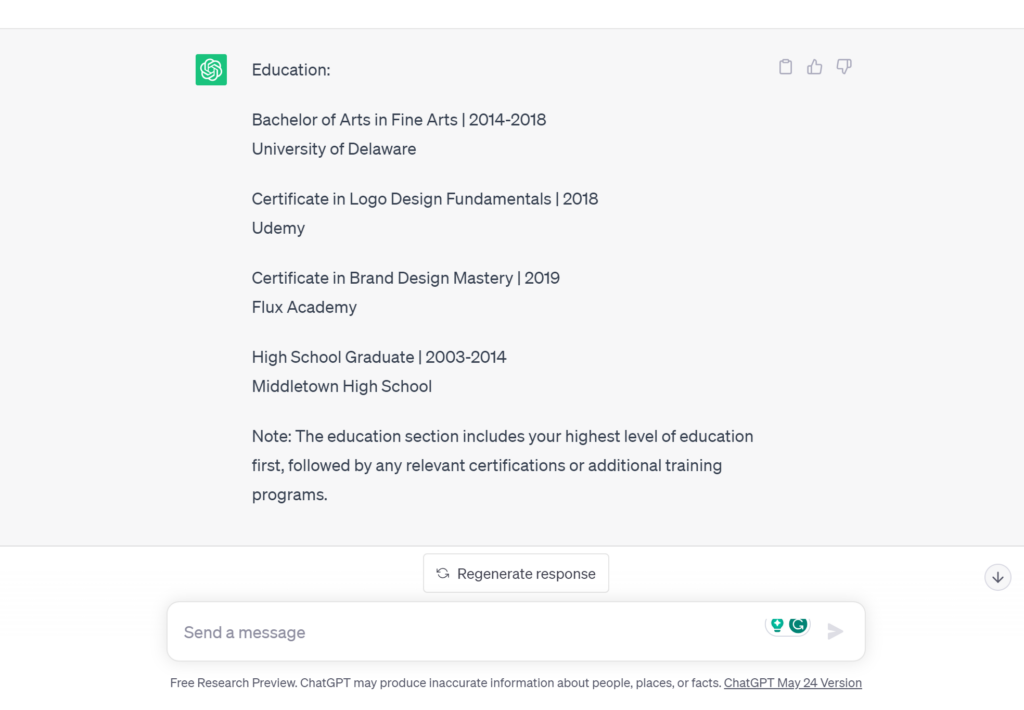
The output also follows the ideal format, which puts the highest level of education first and the lowest last. ChatGPT noted where relevant certifications or additional training programs should be placed. The spacing between the educational level and the years is the only detail you want to tweak. In standard resumes, the timelines are usually aligned to the right, but since ChatGPT has a narrow context window, it followed the format it was pre-trained to generate.
Before we proceed, let’s try a less structured prompt and observe how ChatGPT translates it into an education section of a resume. Use this prompt:
Create the education section of my resume. I studied at [school name] from [year range], graduating high school. I had my [bachelor’s degree] at the [college or university] from [year range]. I earned a [certificate, diploma, training, etc] in [year]. Then I earned [additional certificate, diploma, training, etc.] in [year]. 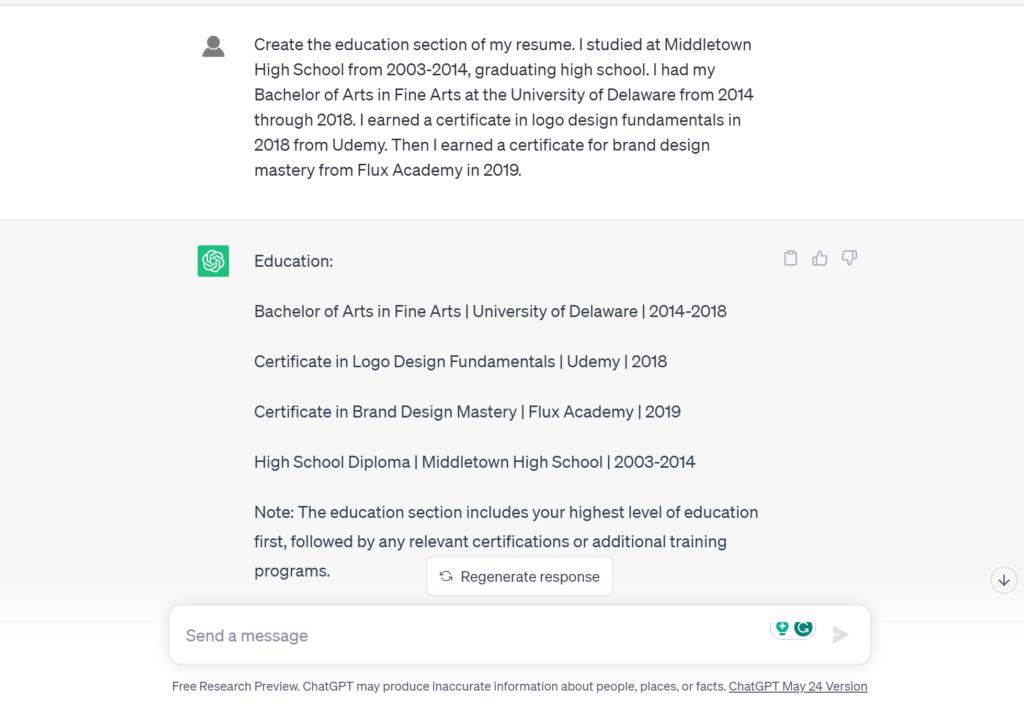
ChatGPT provided a different format in this scenario. While it’s technically not incorrect, the response demonstrates ChatGPT’s small context window when it comes to prompts that aren’t as specified and structured as the ones we previously provided.
Let’s proceed to the next step.
Step 7 – If applicable, type any relevant awards you’ve received in the prompt field and ask ChatGPT to create your resume’s awards and recognitions section.
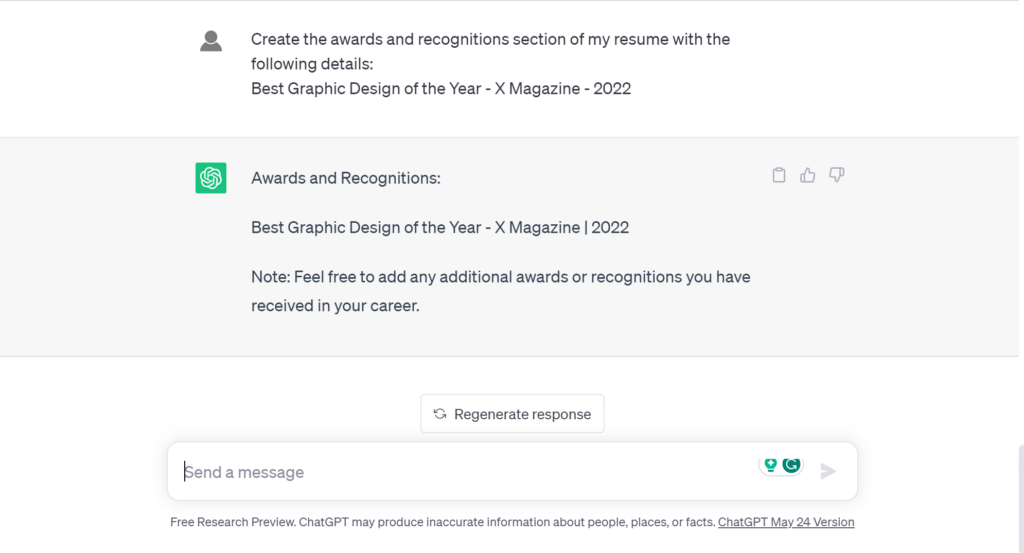
Despite ChatGPT’s narrow context window, its performance for this approach is remarkable. You can copy everything and paste it to your downloaded resume template or a blank document and adjust the font sizes and alignments. View the full chat and experiment with these prompts to create your standout resume.
As a final but optional step, ask ChatGPT to generate a resume out of all its responses. Compare the output to the resume you’ve built by copying and pasting ChatGPT’s previous responses. Use this prompt:
Create a resume for a/an [position] candidate out of your previous responses.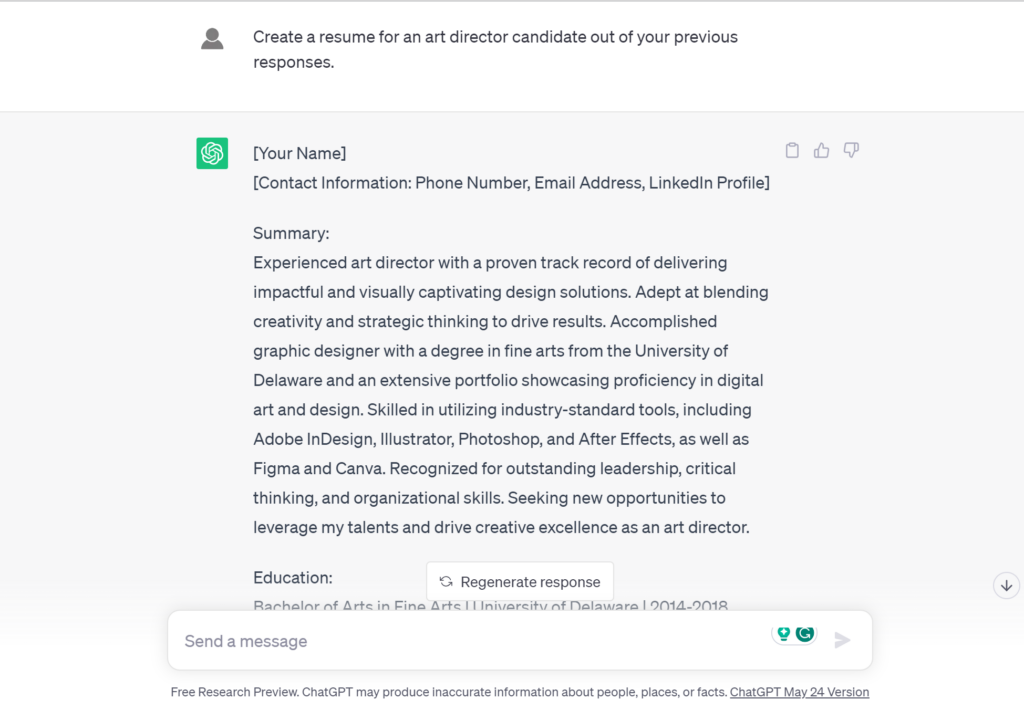

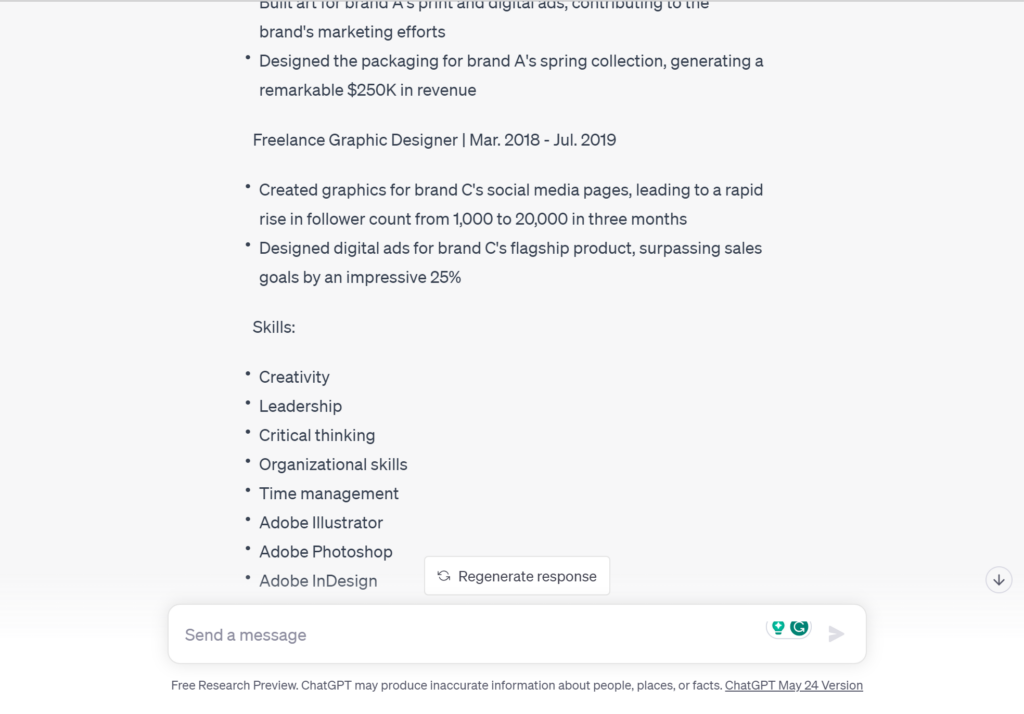

ChatGPT’s format is a bit different from the ideal structure we showed earlier, putting the education section before professional experience.
While some sources may consider this format correct, putting your work history first is more appropriate if you’re already an experienced professional. On the other hand, displaying the education section first befits fresh graduates or internship candidates.
It’s worth noting, though, that ChatGPT placed the skills section at the bottom, aligning with what we’ve previously stated about using bullet points to outline your skills.
As for the link to your portfolio, which is required for roles in the content, creative, and technological fields, the perfect place for it is between the summary and skills section, but many employers today use a platform where you can paste links or upload files. In that case, you don’t need to insert a link to your resume.
Let’s move on to the next approach.
Asking ChatGPT for Feedback on Your Resume
If you already have a resume, but your applications don’t seem to stand out, you can ask ChatGPT where your resume falls short. Here’s how to do that.
Step 1 – Paste your resume to the prompt field and ask ChatGPT to provide feedback. Use this prompt:
Provide comprehensive feedback for the pasted resume below.
“[your resume]”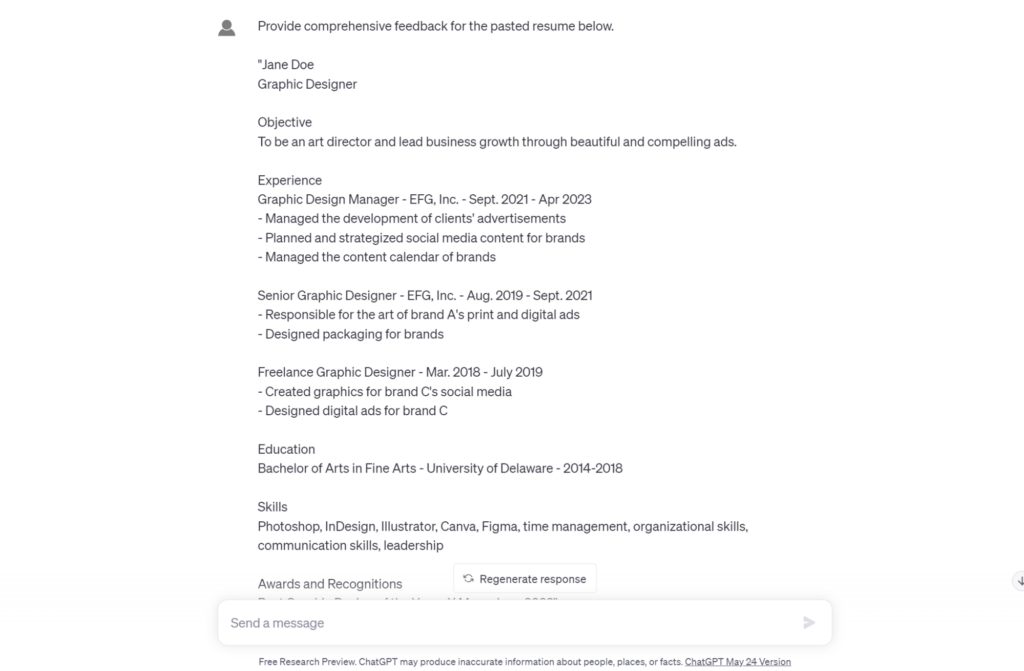
Step 2 – Review ChatGPT’s feedback.
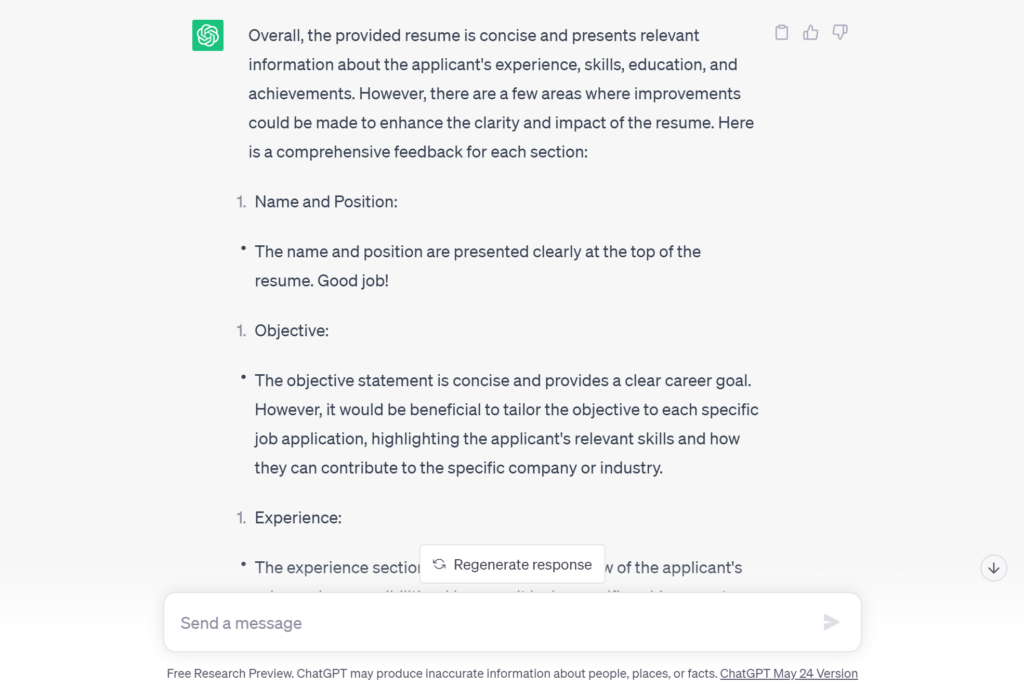
ChatGPT pointed out areas of improvement for the objective, stating that it should be tailored to a specific job application and that the candidate’s skills and potential value to the company should be highlighted. These are valid points because the objective we provided was vague.
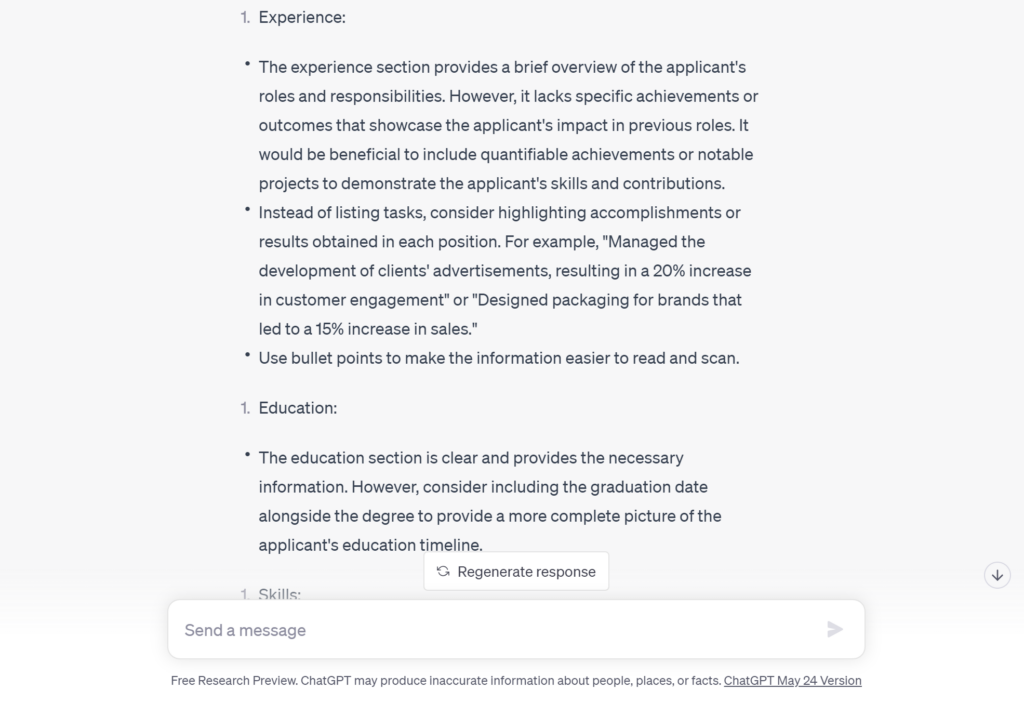
ChatGPT identified significant weaknesses in the experience section as well. It explained how we could improve this section by quantifying our achievements instead of merely listing tasks. This feedback aligns with the ideal resume format we previously presented.
There were areas of improvement found in the education section as well. However, according to career experts, no rule requires putting your graduation year in your resume. In fact, certified career coach and Careers Done Write founder Debra Wheatman advises removing graduation dates and any indicators of age from your resume once you’ve accumulated 10 to 15 years of experience. This strategy allows hiring managers to focus on your skills and accomplishments instead of your age.
Let’s check out ChatGPT’s feedback on the rest of the resume.

ChatGPT provided a recommendation for the skills section, but following it is entirely optional. Indeed Career Guide recommends listing marketable skills like time management, communication, leadership, and computer skills, among others. The only possible exception to this “rule” is if you’re in tech, unless you’re targeting management or leadership positions. But in any case, with ATS scanning resumes for recruiters, skill subcategories will not matter as much as keywords.
The awards and recognition section was generally impressive for ChatGPT. Overall, our sample resume could do with significant improvements, which ChatGPT successfully identified and explained. Its comprehensive feedback gives you a clearer picture of a standout resume. Try the prompts we gave the LLM to give your resume some much-needed fine-tuning.
Asking ChatGPT to Make Specific Changes to Your Resume
One of the trickiest aspects of writing a resume is the professional experience section. Your work history must demonstrate your expertise and highlight the qualities that set you apart from other candidates.
For this approach, we’ll ask ChatGPT to enhance our resume’s professional experience section. We’ll use the one ChatGPT generated for us in the previous approach and see if AI can improve it further.
Step 1 – Paste the professional experiences section of your resume in the prompt field and ask ChatGPT to improve it. Use this simple prompt:
Enhance this section of my resume:
“[ChatGPT-generated professional section of your resume from Approach 1]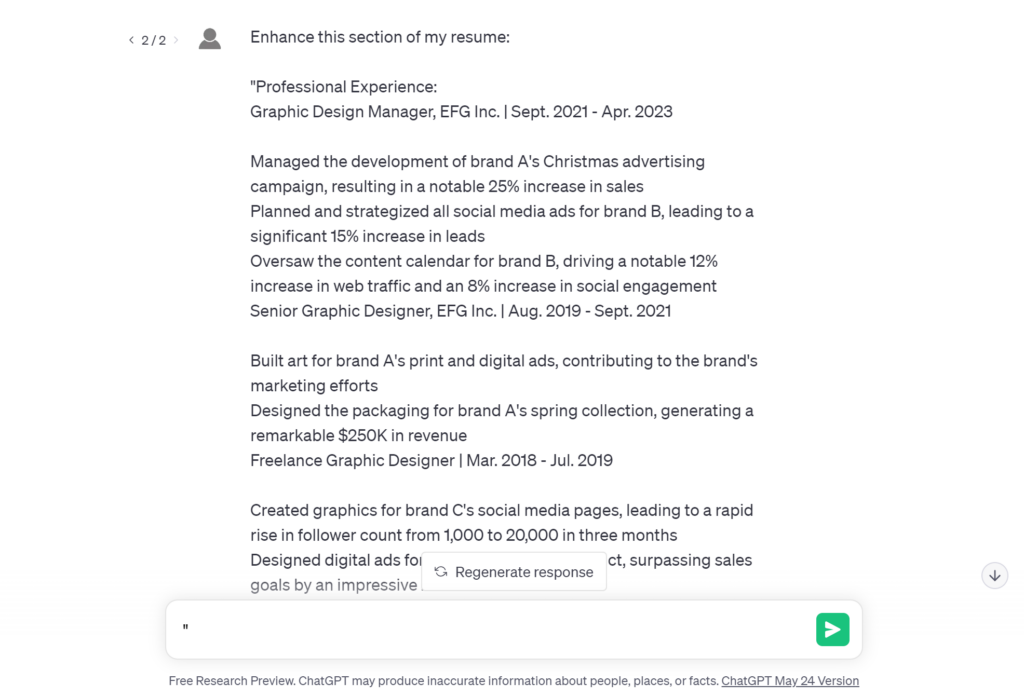
Step 2 – Compare ChatGPT’s response to its previous output.
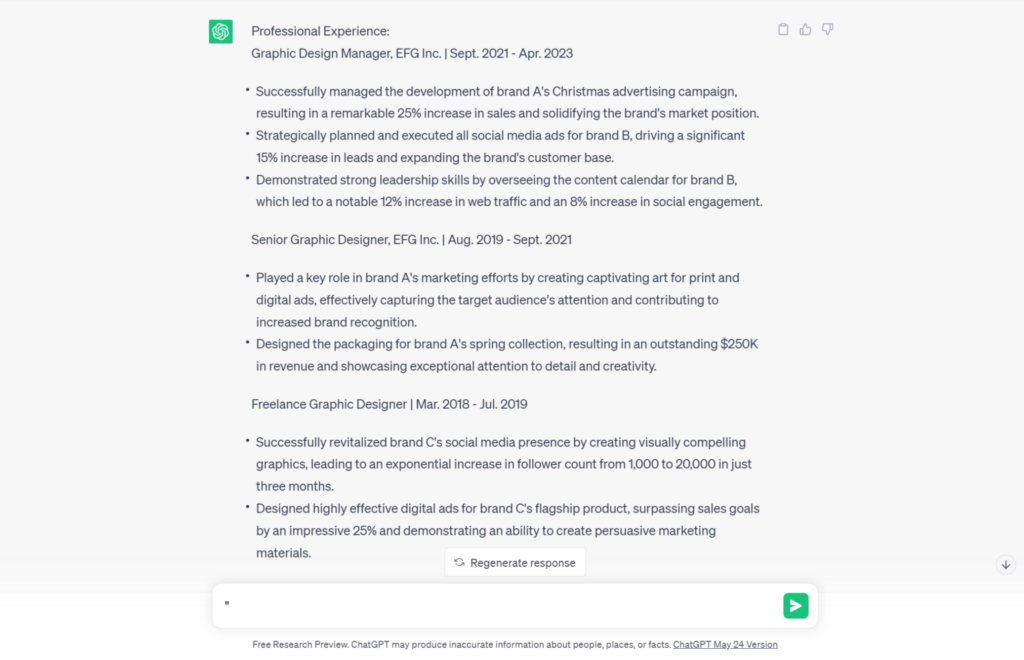
Structure-wise, there’s not much difference in this version. Each point starts with a verb, only in this enhanced version, adverbs such as “successfully,” and “strategically” are added, which can help market the candidate’s potential better. Moreover, the phrase “effectively capturing the target audience’s attention and contributing to increased brand recognition” sounds unmistakably more powerful than “contributing to the brand’s marketing efforts.”
ChatGPT’s performance in this approach is remarkable, producing a perfectly usable resume section. View the full chat here and try the prompt for the other parts of your resume.
Asking ChatGPT to Rewrite Your Resume Using the Best Practices
The best practices in writing a resume may depend on factors such as the industry, job title, and general aspects. Professionals in the creative field may be expected to hand out creatively-designed resumes, while those in more analytical areas may stand out with resumes in minimalistic templates. To make ChatGPT’s output universal and thus helpful to many, we’ll focus on general aspects as we ask it to rewrite our resume based on the best practices.
Step 1 – Ask ChatGPT what the best practices for resume writing are. Use this prompt:
What are the best practices in writing a resume?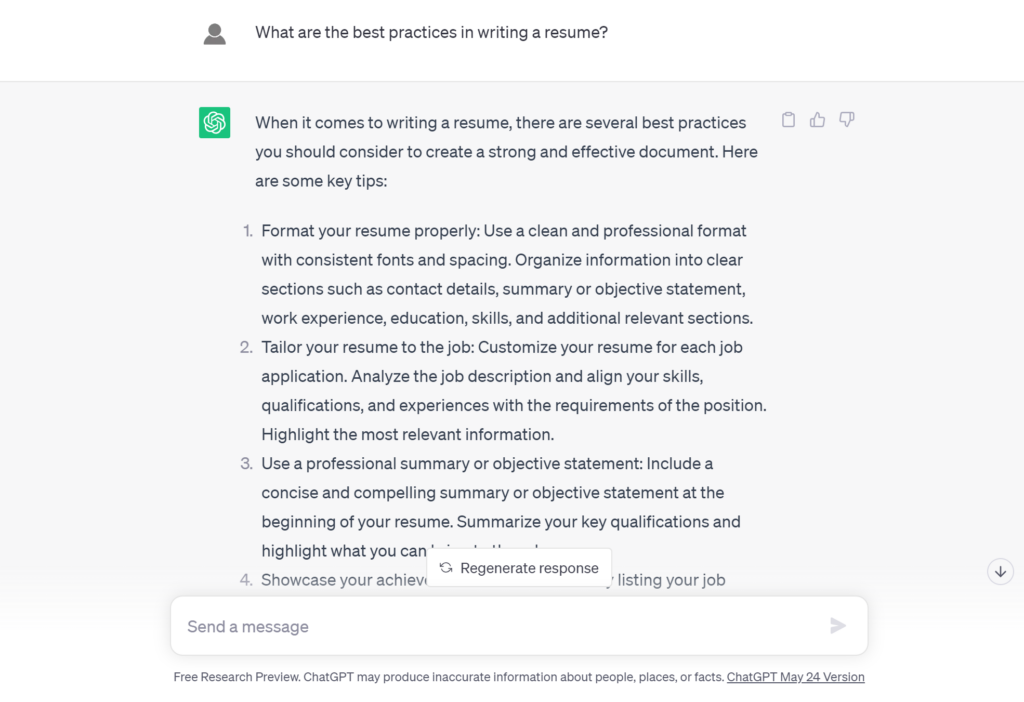


ChatGPT generated a comprehensive list of best practices aligned with a resume’s ideal characteristics, including quantified achievements, relevant experiences, professional formatting, and context. It also adds the tip of customizing your resume for every job application. This is valuable advice because even if you’re mainly targeting a specific job title, opportunities may come in other roles that are also relevant in your industry or field.
Step 2 – Ask ChatGPT to rewrite your resume using the best practices. Use this prompt:
Rewrite this resume using the best practices stated above.
“[your resume]”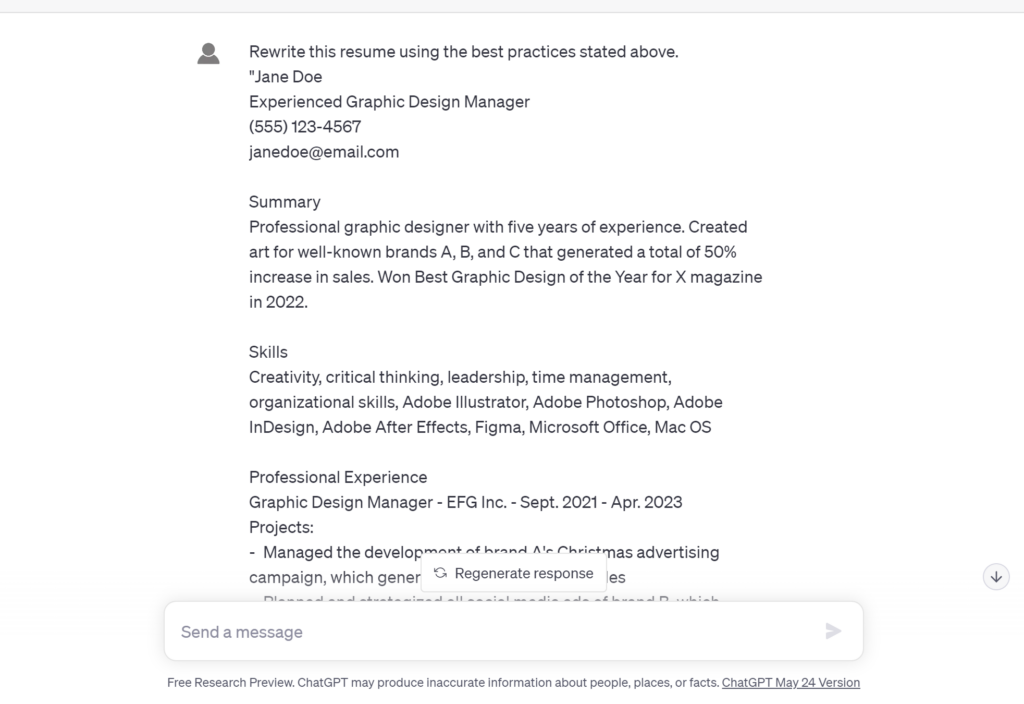

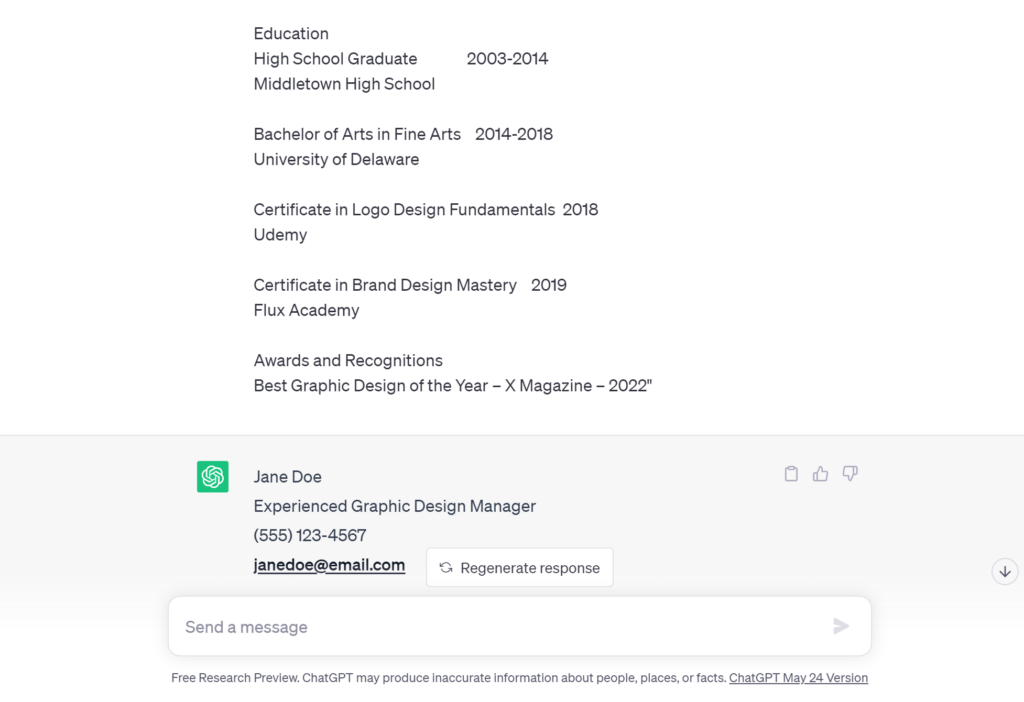
Step 3 – See ChatGPT’s output and compare it to the original resume.
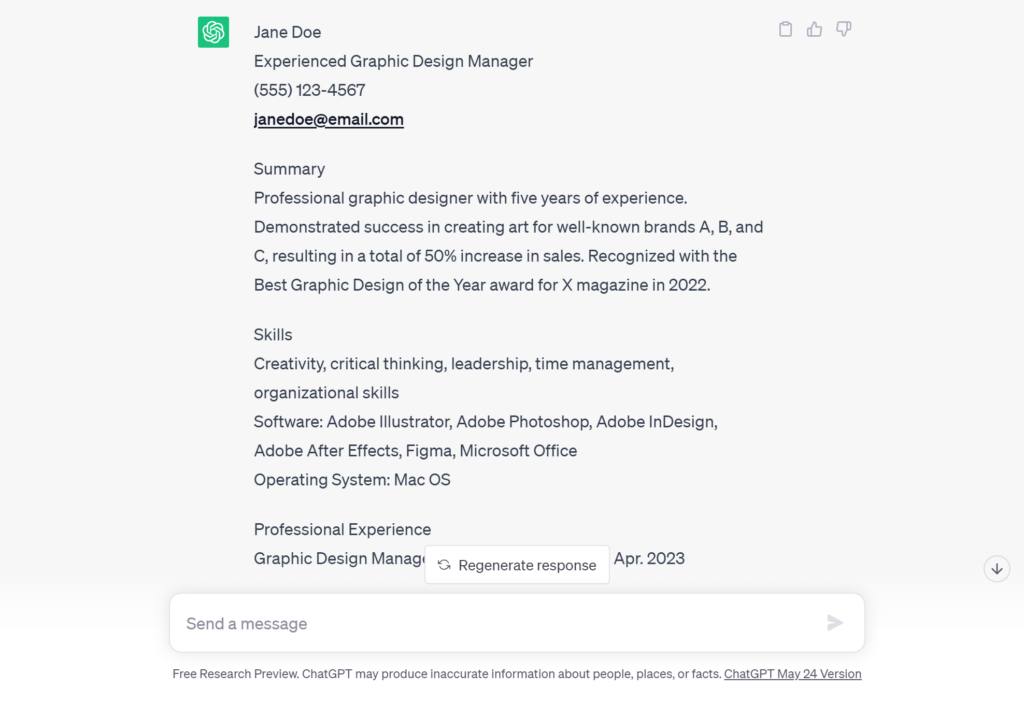
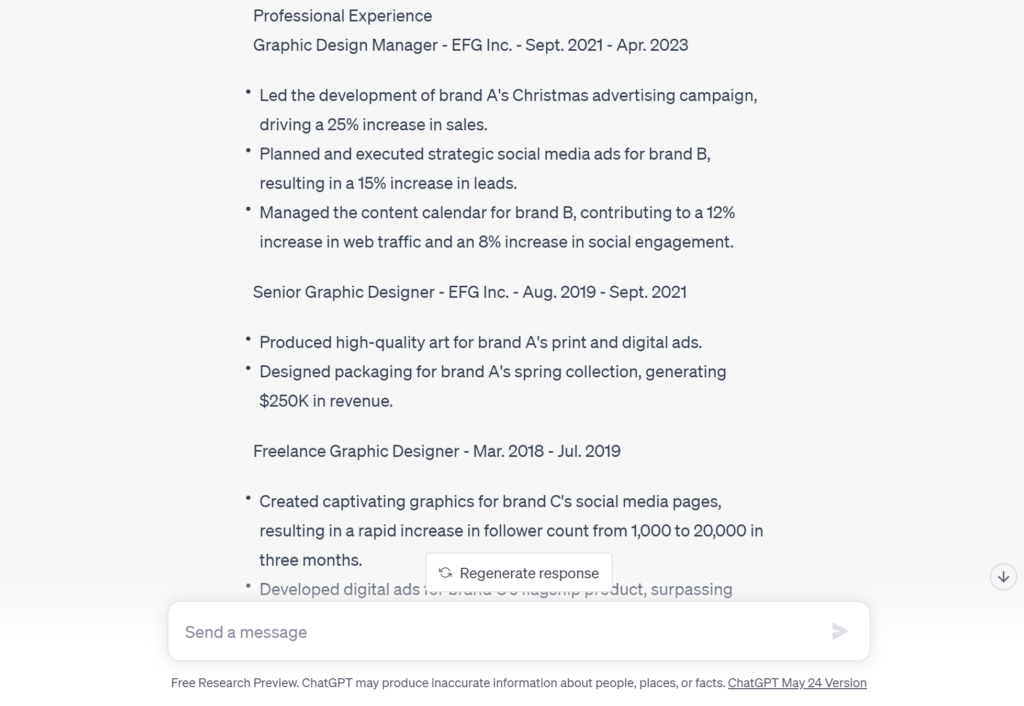
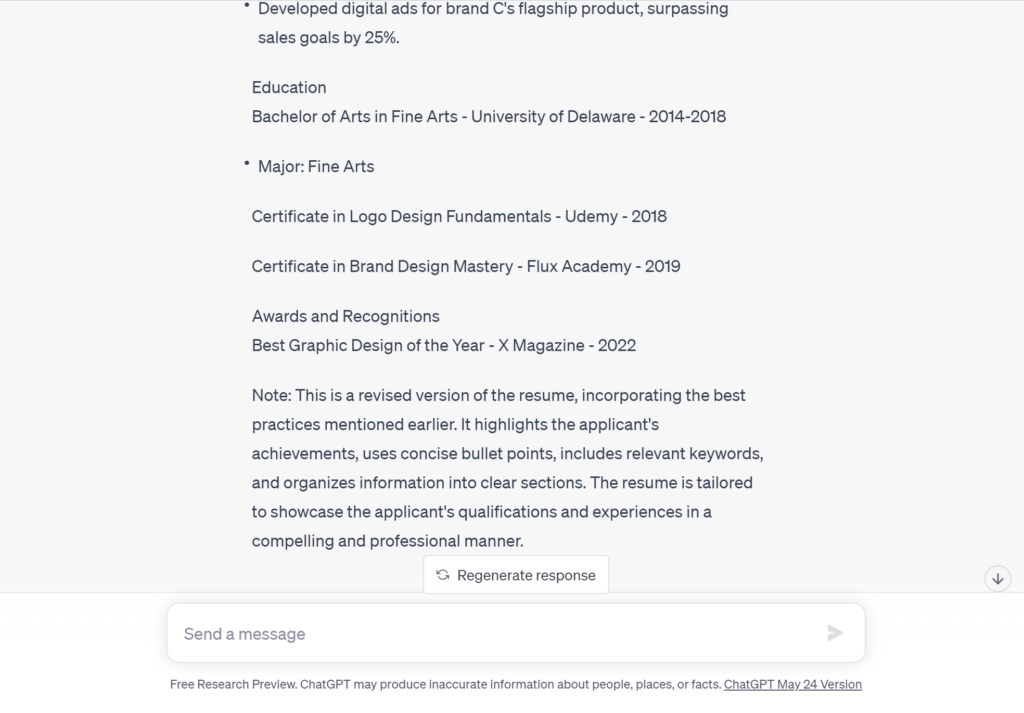
As ChatGPT says, this revised resume follows the best practices and highlights the candidate’s achievements. It produced a short but compelling summary, used bullet points for readability, and professionally outlined the candidate’s qualifications. This improved resume represents the candidate better and increases their chances for a callback.
Considerations for Writing Your Resume with ChatGPT
ChatGPT has proven itself helpful for writing standout resumes. It identifies areas of improvement and revises specific sections impeccably. Its tips help candidates fine-tune their writing and highlight their most remarkable accomplishments. Fresh graduates can also benefit from ChatGPT because it helps pitch them effectively as a newcomer.
Approaches 1 and 4 (asking for a resume and rewriting a resume based on best practices) are the most beneficial because the first one helps you start from scratch, while the fourth approach improves your resume with tips you can use no matter which industry you specialize in.
However, note that ChatGPT only holds data from 2021 and earlier. If you use it to research your industry’s most recent standards on recruitment, you won’t get the most updated information.
Frequently Asked Questions
Can ChatGPT write a resume? Should I use it?
Yes, ChatGPT can write a resume, rewrite a resume, and edit specific parts of a resume. You should try using it, especially if your resume isn’t getting you callbacks.
What mistakes should I avoid when writing a resume with ChatGPT?
Avoid vague prompts to allow ChatGPT to generate the best output possible. Although the LLM can expound on the details you provided, your resume will represent you better if you provide specific information, like job titles and quantified accomplishments.
This goes without saying, but you should also avoid putting false information in your resume when using ChatGPT to improve it. It may result in a convincing output, but recruiters and hiring managers likely have means of verifying information in resumes, so it’s not a risk worth taking.
In addition, it may be best to exclude your address when pasting your resume into ChatGPT’s prompt field. While OpenAI won’t use such personal information to build user profiles and sell or advertise their services, it uses people’s data to improve ChatGPT. If you wish to input personal details into your prompts, you may turn off chat history to protect your privacy.
Can employers tell if I used ChatGPT to write my resume?
If employers use tools like ZeroGPT or OpenAI Classifier, they may learn that your resume is AI-generated. This won’t necessarily impact your chances of getting a callback unless the employer explicitly states that they don’t accept candidates using generative AI tools.
To decrease the odds of detectors identifying your resume as AI generated, you can explore Playground, an OpenAI tool with customizable parameters. It’s significantly more advanced than ChatGPT and is in fact designed for developers, but tech novices can play around with it, too. Simply set Playground’s temperature setting to “1” to manipulate AI detectors into believing that your resume is human-written.
How else can I use ChatGPT for job-hunting?
ChatGPT can also help you write a cover letter and draft interview answers. Unfortunately, you can’t use it to search for jobs because its database only holds text from 2021 and the years prior.
Are there other AI tools than ChatGPT that write resumes?
Absolutely! ChatGPT is not the only way you can build an awesome resume using Artificial Intelligence. In fact, we have written an article with the 6 best AI resume builders. If you want something more straightforward than ChatGPT, this may be for you.
Final Thoughts
Many industries and job functions are now incorporating AI, making it essential to leverage the power of ChatGPT and other similar tools to stay competitive in today’s job market. To unlock ChatGPT’s full potential, mastering prompt engineering is crucial, and it requires practice and experimentation with various requests.
Discover the approach that ignites a response that truly speaks to you. With AI as your trusted ally, you’ll effortlessly stay in the know about the latest technological trends shaping the job-hunting landscape.
Sources
- Garland, Stacie. “Soft Skills vs Hard Skills: Which Is More Important in the Workplace?” Vervoe, December 15, 2022. https://vervoe.com/hard-skills-vs-soft-skills/
- Henderson, Robert. “What Is An ATS? 8 Things You Need to Know About Applicant Tracking Systems”. Jobscan, May 25, 2023. https://www.jobscan.co/blog/8-things-you-need-to-know-about-applicant-tracking-systems/
- Indeed Editorial Team. “10 Best Skills To Put On Your Resume (With Examples and FAQ)”. Indeed, June 30, 2023. https://www.indeed.com/career-advice/resumes-cover-letters/best-resume-skills
- Thottam, Isabel. “Should you remove your graduation year from your resume?”. Monster, Accessed July 5, 2023. https://www.monster.com/career-advice/article/should-i-remove-graduation-year-from-resume
- Umoh, Ruth. “This is the age when you should remove your graduation year from your resume”. CNBC, July 8, 2018. https://www.cnbc.com/2018/07/06/heres-when-you-should-remove-your-graduation-year-from-your-resume.html
A formidable prompt engineer, Dan Sanz blends a deep understanding of AI with practical insights into human-machine interaction. His work in prompt engineering in combination with years in the field of Data Science, are helping to redefine the possibilities for AI communication and engagement.

